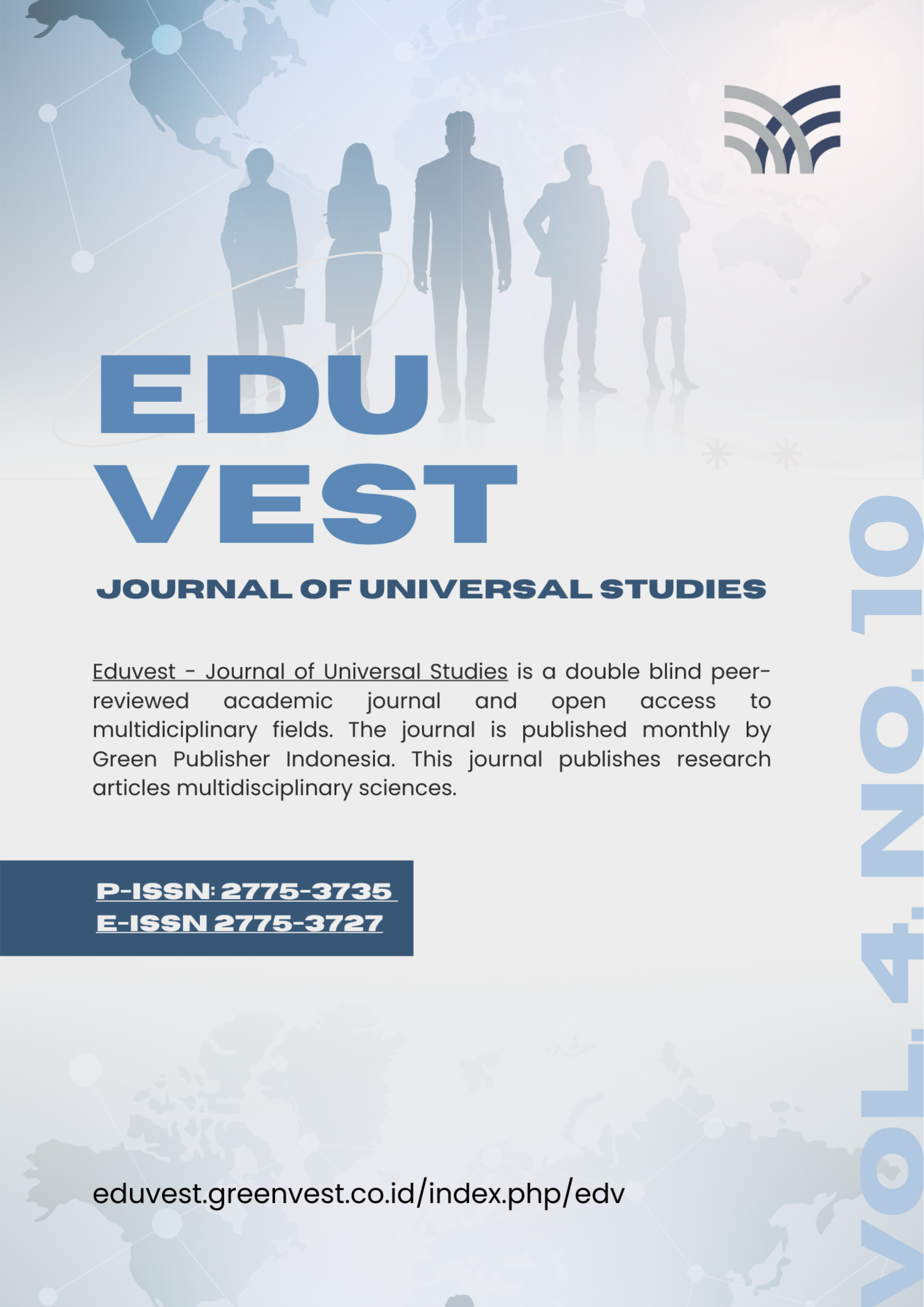Analysis of Nutritional Status, Body Composition, and Creatinine Levels in Hemodialysis Patients at Ibnu Sina Yw-Umi Hospital Makassar
DOI:
https://doi.org/10.59188/eduvest.v4i10.43693Keywords:
Nutritional Status, Body Composition, Creatinine Levels, Hemodialysis, Chronic Kidney Disease, Ibnu Sina YW-UMI HospitalAbstract
Hemodialysis is an essential therapy for managing chronic kidney failure, helping to maintain homeostasis by removing excess fluids, solutes, and toxins from the body. The global increase in the prevalence of chronic kidney disease (CKD) has led to a rising demand for hemodialysis. This study aims to analyze the relationship between nutritional status, body composition, and creatinine levels in hemodialysis patients at Ibnu Sina YW-UMI Makassar Hospital. Using an observational cross-sectional design, the study involved 16 patients whose body mass index (BMI), muscle mass, fat mass, total body fluid, and visceral fat were measured before and after dialysis. The results revealed significant changes in nutritional status, body composition, and creatinine levels pre- and post-hemodialysis, analyzed through paired T-tests at a 0.05 confidence level. Most patients were male, aged over 45, with normal nutritional status but abnormal creatinine levels. Body composition analysis showed significant differences in muscle mass, fat mass, total body fluid, and visceral fat before and after hemodialysis, with patients with higher muscle mass tending to have elevated creatinine levels. This study emphasizes the importance of monitoring body composition and creatinine levels to support the health of hemodialysis patients and highlights the need for personalized nutritional and therapeutic interventions in CKD care. Further research is needed to explore the long-term impacts of hemodialysis on nutritional status and kidney function.
References
Beberashvili, I., Azar, A., Khatib, A., Hamad, R. A., Neheman, A., Efrati, S., & Doenyas-Barak, K. (2023). Sarcopenic obesity versus nonobese sarcopenia in hemodialysis patients: differences in nutritional status, quality of life, and clinical outcomes. Journal of Renal Nutrition, 33(1), 147–156.
Bowry, S. K., & Chazot, C. (2021). The scientific principles and technological determinants of haemodialysis membranes. Clinical Kidney Journal, 14(Supplement_4), i5–i16.
Dewi, R. T. K., Putranto, W., Susanto, A., Suseno, A., Purwanto, B., Mangesti, R. D., Giani, M. T., & Septian, M. R. (2020). Hubungan Kualitas Hidup dan Status Nutrisi pada Pasien Penyakit Ginjal Kronik dengan Tipe Dialisis. Jurnal Penyakit Dalam Indonesia, 7(1), 22. https://doi.org/10.7454/jpdi.v7i1.381
Eduok, U., Abdelrasoul, A., Shoker, A., & Doan, H. (2021). Recent developments, current challenges and future perspectives on cellulosic hemodialysis membranes for highly efficient clearance of uremic toxins. Materials Today Communications, 27, 102183.
Kemenkes RI. (2018). Hasil Riset Kesehatan Dasar Tahun 2018. Kementrian Kesehatan RI, 53(9), 1689–1699.
Kemenkes RI. (2023). Keputusan Menteri Kesehatan Republik Indonesia. Pedoman Nasional Pelayanan Kedokteran Tatalaksana Ginjal Kronik.
Mallappallil, M., Friedman, E. A., Delano, B. G., McFarlane, S. I., & Salifu, M. O. (2014). Chronic Kidney Disease in The Elderly: Evaluation and Management. National Centre for Biotechnology Information, 11(5), 525–535.
Ma’shumah, N., Bintanah, S., & Handarsari, E. (2014). Hubungan Asupan Protein Dengan Kadar Ureum, Kreatinin, dan Kadar Hemoglobin Darah pada Penderita Gagal Ginjal Kronik Hemodialisa Rawat Jalan Di RS Tugurejo Semarang. Jurnal Gizi Universitas Muhammadiyah Semarang, 3(1), 22–32.
Mollahosseini, A., Abdelrasoul, A., & Shoker, A. (2020). A critical review of recent advances in hemodialysis membranes hemocompatibility and guidelines for future development. Materials Chemistry and Physics, 248, 122911.
Piccoli, G. B., Lippi, F., Fois, A., Gendrot, L., Nielsen, L., Vigreux, J., Chatrenet, A., D’Alessandro, C., Cabiddu, G., & Cupisti, A. (2020). Intradialytic nutrition and hemodialysis prescriptions: a personalized stepwise approach. Nutrients, 12(3), 785.
Priyanto, I., Budiwiyono, I., & W, N. S. (2018). Hubungan Kadar Kreatinin Dengan Formula Huge (Hematocrit, Urea, Gender) Pada Pasien Penyakit Ginjal Kronik Media Medika Muda. Media Medika Muda, 3(2), 1–6.
Sahathevan, S., Karupaiah, T., Khor, B.-H., Sadu Singh, B. K., Mat Daud, Z. A., Fiaccadori, E., Sabatino, A., Chinna, K., Abdul Gafor, A. H., & Bavanandan, S. (2021). Muscle status response to oral nutritional supplementation in hemodialysis patients with protein energy wasting: a multi-center randomized, open label-controlled trial. Frontiers in Nutrition, 8, 743324.
Salawati, L. (2016). Analisis Lama Hemodialisis dengan Status Gizi Penderita Penyakit Ginjal Kronik. Jurnal Kedokteran Syiah Kuala, 16(2), 64–68.
Santika, K., & Rahman, S. (2021). Faktor Penyebab Penyakit Ginjal Kronik pada Pasien yang Menjalani Terapi Hemodialisis di Unit Hemodialisis Rumah Sakit Khusus Ginjal Rasyida Medan Tahun 2019. Jurnal Ilmiah Simantek, 5(2), 15–19.
Setiawan, I., & Purbianto, P. (2023). Effect of Hemodialysis on Nutritional Status in Chronic Renal Failure Patients. Journal of Noncommunicable Diseases Prevention and Control, 1(1), 13–19. https://doi.org/10.61843/jondpac.v1i1.496
Visiedo, L., López, F., Rivas-Ruiz, F., Tortajada, B., Giménez Martínez, R. J., & Abilés, J. (2024). Effect of a personalized nutritional intervention program on nutritional status, quality of life and mortality in hemodialysis patients.
Visiedo, L., Rey, L., Rivas, F., López, F., Tortajada, B., Giménez, R., & Abilés, J. (2022). The impact of nutritional status on health-related quality of life in hemodialysis patients. Scientific Reports, 12(1), 3029.
Ye, H., Ding, H., Gan, W., Wen, P., Zhou, Y., Cao, H., & He, W. (2019). Hemodialysis. In Chronic Kidney Disease: Diagnosis and Treatment (pp. 209–231). StatPearls Publishing. https://doi.org/10.1007/978-981-32-9131-7_17
Published
How to Cite
Issue
Section
License
Copyright (c) 2024 Zulfitriani Murfat, Nurul Zachristi S.Y, Rahmawati, Aryanti R Bamahry, Abdul Mubdi Ardiansar Arifuddin Karim

This work is licensed under a Creative Commons Attribution-ShareAlike 4.0 International License.











